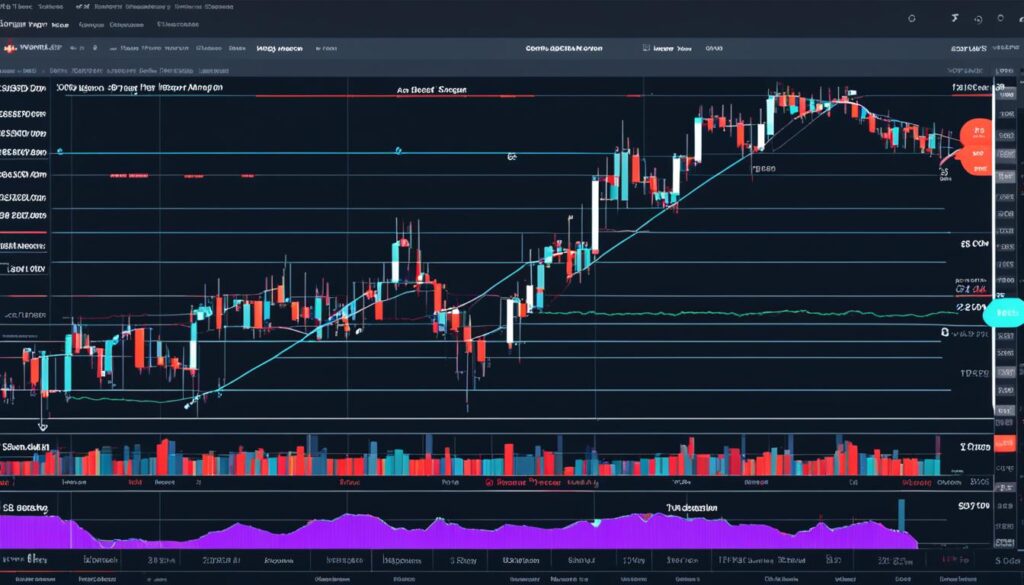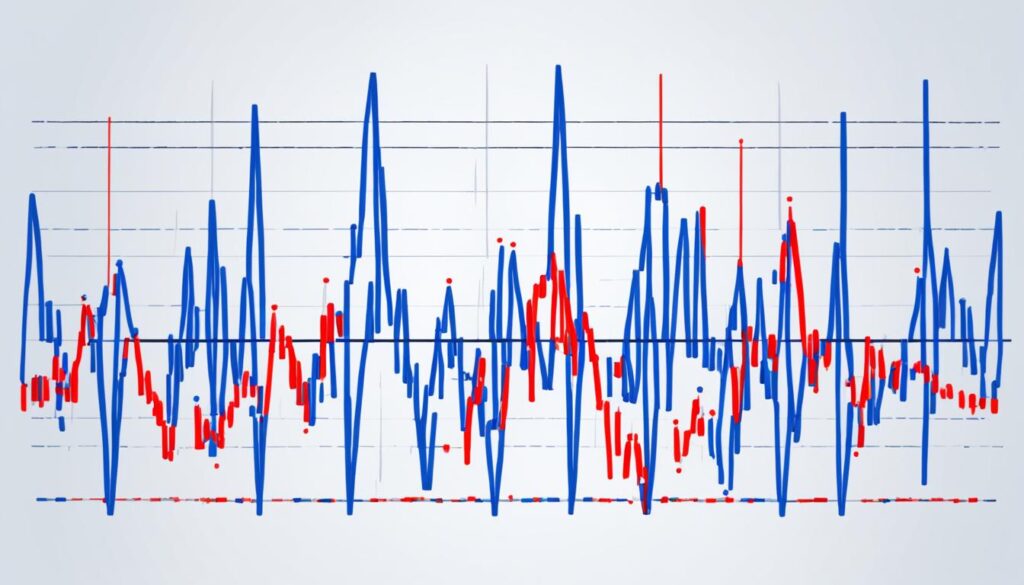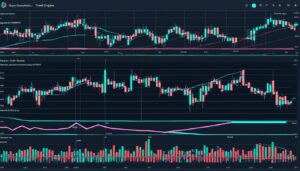As a day trader, I understand the importance of having the right tools at my disposal to make informed decisions in the fast-paced world of trading. One platform that has become a game-changer for many traders is TradingView. With its wide range of indicators, TradingView provides valuable insights to enhance day trading strategies and increase the chances of success.
In this article, I will explore the top indicators on TradingView that have proven to be highly effective for day trading. Whether you are a beginner or an experienced trader, these indicators can help you navigate the markets with confidence and precision.
Key Takeaways
- Moving averages: Simple and exponential moving averages can help identify trends and potential entry and exit points.
- Relative Strength Index (RSI): RSI is a popular indicator for identifying overbought and oversold conditions in the market.
- Bollinger Bands: Bollinger Bands are effective in identifying potential breakouts and reversals.
- Customization: TradingView allows you to customize these indicators based on your preferred settings and timeframes.
- Combine indicators: Combining multiple indicators can provide a more comprehensive view of market trends and improve decision-making.
By incorporating these top indicators into your day trading strategy, you can maximize your chances of success and achieve your trading goals. Let’s dive into each indicator in detail and learn how to leverage them effectively.
Moving Averages
Moving averages play a crucial role in day trading, serving as powerful indicators to identify trends, support and resistance levels, and potential entry and exit points. TradingView, a widely used platform among traders, offers a variety of moving averages to enhance trading strategies and improve decision-making accuracy.
Traders can choose between two main types of moving averages on TradingView: the simple moving average (SMA) and the exponential moving average (EMA). The SMA calculates the average price over a specified period, providing a smooth line that represents the average price movement. On the other hand, the EMA places more weight on recent data, making it more responsive to price changes.
Long-term traders often rely on the 50-day and 200-day moving averages to identify trends in the market. The 50-day moving average reflects short-term price dynamics, while the 200-day moving average provides a broader perspective on long-term trends. By observing the crossovers and slopes of these moving averages, day traders can gain valuable insights into the overall market direction and make well-informed trading decisions.
Shorter-term traders may focus on smaller time frames, such as the 10-day and 20-day moving averages, to capture more immediate price movements. These shorter-term moving averages can help identify short-term trends and potential entry and exit points more effectively.
Let’s take a closer look at the different moving averages and their characteristics:
| Moving Average | Calculation | Characteristics |
|---|---|---|
| Simple Moving Average (SMA) | Average price over a specified period | Smoothes out price fluctuations |
| Exponential Moving Average (EMA) | Places more weight on recent data | More responsive to price changes |
By analyzing the moving average crossovers and slopes, traders can gauge the strength of a trend and identify potential reversal points. When a shorter-term moving average crosses above a longer-term moving average, it indicates a potential uptrend, while a crossover below indicates a potential downtrend.
Remember that moving averages work best in trending markets and may generate false signals in ranging or choppy markets. Therefore, it’s essential to combine moving averages with other technical analysis tools to validate signals and increase trading accuracy.
As you can see, the above image illustrates the power of moving averages in identifying trends and potential reversal points. Traders can utilize moving averages strategically to enhance their day trading strategies and make informed trading decisions based on reliable market insights.
Relative Strength Index (RSI)
The Relative Strength Index (RSI) is a widely used indicator in day trading to identify overbought and oversold conditions in the market. With a range from 0 to 100, the RSI is calculated based on the speed and change in price movements. Traders rely on the RSI to gauge the momentum of an asset and determine potential entry and exit points for their trades.
When the RSI reading goes above 70, it indicates that the asset is overbought. This suggests that the price may have reached unsustainable levels and could potentially reverse or correct. On the other hand, when the RSI reading falls below 30, it suggests that the asset is oversold. This indicates a potential buying opportunity as the price may be due for a reversal and subsequent price increase.
TradingView, a popular trading platform, offers customization options for the RSI indicator, allowing traders to adjust the settings and apply it to different timeframes. This flexibility makes the RSI a versatile tool for day traders who are looking for specific trading opportunities.

RSI Indicator Example
| Date | Price | RSI | Signal |
|---|---|---|---|
| Jan 1, 2022 | $100 | 73 | Overbought |
| Jan 2, 2022 | $95 | 45 | Neutral |
| Jan 3, 2022 | $105 | 82 | Overbought |
| Jan 4, 2022 | $110 | 28 | Oversold |
This table illustrates the RSI readings for a hypothetical asset over a period of time. Traders would typically consider selling their holdings when the RSI crosses above 70 and indicates an overbought condition. Conversely, they might consider buying when the RSI falls below 30 and indicates an oversold condition.
Bollinger Bands
Bollinger Bands are a popular volatility indicator that can greatly assist day traders in identifying potential breakouts and reversals. This versatile technical analysis tool consists of three lines: a simple moving average (SMA) in the center and two standard deviation lines above and below the SMA.
The width of the Bollinger Bands expands when the market volatility increases, indicating potentially significant price movements, and contracts when the volatility decreases, suggesting a period of decreased market activity.
The purpose of Bollinger Bands is to provide day traders with insights into the market’s volatility and to help identify trading opportunities in fluctuating price environments. By visually representing the upper and lower limits of price movement, Bollinger Bands assist traders in determining potential entry and exit points for trades.
When prices reach the upper band, it could indicate that the market is overbought, potentially leading to a reversal or correction. Conversely, prices reaching the lower band may suggest that the market is oversold, providing a potential buying opportunity.
When used in conjunction with other technical analysis tools such as candlestick patterns or trendlines, Bollinger Bands can enhance a trader’s understanding of price movements and aid in making more accurate predictions.
| Advantages of Bollinger Bands | Disadvantages of Bollinger Bands |
|---|---|
|
|
By incorporating Bollinger Bands into their day trading strategies, traders can gain valuable insights into market volatility and potentially improve their trading decisions. However, it is essential to use Bollinger Bands in conjunction with other indicators and analysis techniques to validate signals and avoid false trading signals.

Conclusion
In conclusion, the right indicators play a critical role in the success of day traders in the financial markets. TradingView offers a vast selection of indicators that can be tailored to suit individual trading strategies. Some of the top indicators available on TradingView include moving averages, the relative strength index (RSI), and Bollinger Bands, which provide valuable insights into market trends, potential entry and exit points, and volatility.
By incorporating these indicators into their day trading strategies, traders can significantly increase their chances of achieving success in their trades. Moving averages help identify trends and key support and resistance levels, while the RSI assists in identifying overbought and oversold conditions. Bollinger Bands, on the other hand, are particularly useful for identifying potential breakouts and reversals in volatile market conditions.
Successful day trading requires a combination of technical and fundamental analysis, as well as the ability to interpret and utilize trading indicators effectively. The indicators offered on TradingView are powerful tools that can aid day traders in making informed trading decisions. By leveraging these indicators and adjusting them to their specific trading style, traders can optimize their strategies and increase their profitability.
FAQ
What are the best indicators for day trading on TradingView?
The best indicators for day trading on TradingView include moving averages, the Relative Strength Index (RSI), and Bollinger Bands.
How do moving averages help in day trading?
Moving averages help identify trends, support and resistance levels, and potential entry and exit points.
What types of moving averages are available on TradingView?
TradingView offers various types of moving averages, including simple moving averages (SMA) and exponential moving averages (EMA).
What is the purpose of the Relative Strength Index (RSI) in day trading?
The RSI is used to identify overbought and oversold conditions in the market, indicating potential reversals or buying opportunities.
How can Bollinger Bands help day traders?
Bollinger Bands help identify potential breakouts and reversals by measuring volatility in the market.
Source Links
- https://thomas-henniges.de/new/education-for-stock-trading.html
- https://www.ig.com/en/news-and-trade-ideas/_gbp-usd-remains-under-pressure-while-eur-jpy–usd-jpy-recover-240301
- https://www.cryptoglobe.com/latest/2024/03/ada-whale-says-cardano-continues-to-defy-critics-the-fundamental-story-of-cardano-is-still-not-going-away/
Disclaimer
All information on this website is of a general nature. The information is not adapted to conditions that are specific to your person or entity. The information provided can not be considered as personal, professional or legal advice or investment advice to the user.
This website and all information is intended for educational purposes only and does not give financial advice. Signal Mastermind Signals is not a service to provide legal and financial advice; any information provided here is only the personal opinion of the author (not advice or financial advice in any sense, and in the sense of any act, ordinance or law of any country) and must not be used for financial activities. Signal Mastermind Signals does not offer, operate or provide financial, brokerage, commercial or investment services and is not a financial advisor. Rather, Signal Mastermind Signals is an educational site and a platform for exchanging Forex information. Whenever information is disclosed, whether express or implied, about profit or revenue, it is not a guarantee. No method or trading system ensures that it will generate a profit, so always remember that trade can lead to a loss. Trading responsibility, whether resulting in profits or losses, is yours and you must agree not to hold Signal Mastermind Signals or other information providers that are responsible in any way whatsoever. The use of the system means that the user accepts Disclaimer and Terms of Use.
Signal Mastermind Signals is not represented as a registered investment consultant or brokerage dealer nor offers to buy or sell any of the financial instruments mentioned in the service offered.
While Signal Mastermind Signals believes that the content provided is accurate, there are no explicit or implied warranties of accuracy. The information provided is believed to be reliable; Signal Mastermind Signals does not guarantee the accuracy or completeness of the information provided. Third parties refer to Signal Mastermind Signals to provide technology and information if a third party fails, and then there is a risk that the information may be delayed or not delivered at all.
All information and comments contained on this website, including but not limited to, opinions, analyzes, news, prices, research, and general, do not constitute investment advice or an invitation to buy or sell any type of instrument. Signal Mastermind Signals assumes no responsibility for any loss or damage that may result, directly or indirectly, from the use or dependence on such information.
All information contained on this web site is a personal opinion or belief of the author. None of these data is a recommendation or financial advice in any sense, also within the meaning of any commercial act or law. Writers, publishers and affiliates of Signal Mastermind Signals are not responsible for your trading in any way.
The information and opinions contained in the site are provided for information only and for educational reasons, should never be considered as direct or indirect advice to open a trading account and / or invest money in Forex trading with any Forex company . Signal Mastermind Signals assumes no responsibility for any decisions taken by the user to create a merchant account with any of the brokers listed on this website. Anyone who decides to set up a trading account or use the services, free of charge or paid, to any of the Broker companies mentioned on this website, bears full responsibility for their actions.
Any institution that offers a service and is listed on this website, including forex brokers, financial companies and other institutions, is present only for informational purposes. All ratings, ratings, banners, reviews, or other information found for any of the above-mentioned institutions are provided in a strictly objective manner and according to the best possible reflection of the materials on the official website of the company.
Forex/CFD trading is potentially high risk and may not be suitable for all investors. The high level of leverage can work both for and against traders. Before each Forex/CFD investment, you should carefully consider your goals, past experience and risk level. The opinions and data contained on this site should not be considered as suggestions or advice for the sale or purchase of currency or other instruments. Past results do not show or guarantee future results.
Neither Signal Mastermind Signals nor its affiliates ensure the accuracy of the content provided on this Site. You explicitly agree that viewing, visiting or using this website is at your own risk.


